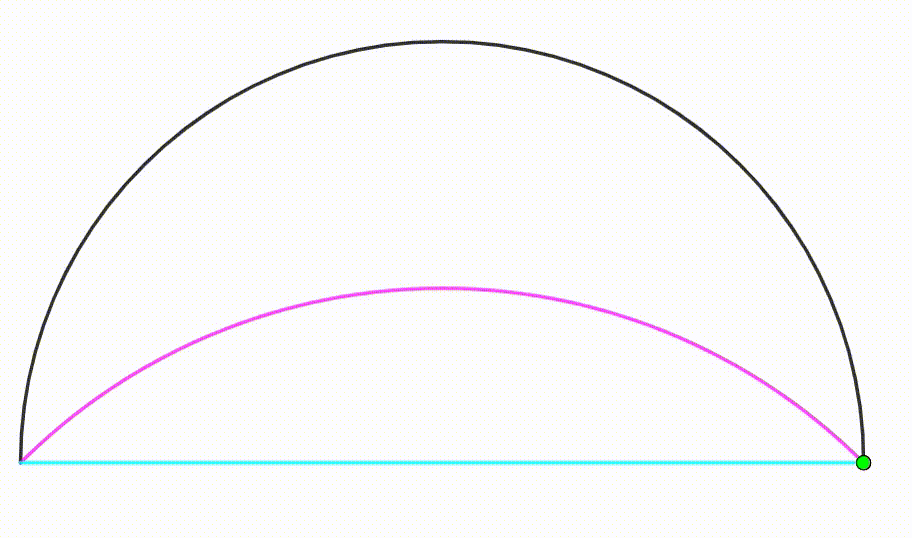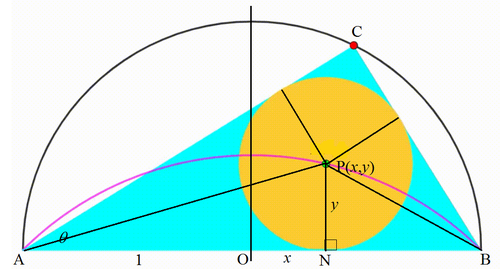Dynamic Geometry: P46
 The diagram shows a black semicircle with radius
1
. A red point is moving on the semicircle so that we can draw a cyan triangle using the red point and the black semicircle's diameter. The yellow circle is the triangle's incircle. The center of the incircle (green point) traces a
locus
(pink curve). When the sides of the cyan triangle are in arithmetic progression, the ratio of the incircle's area to the area bounded by the pink curve and the black semicircle's diameter can be expressed as:
The diagram shows a black semicircle with radius
1
. A red point is moving on the semicircle so that we can draw a cyan triangle using the red point and the black semicircle's diameter. The yellow circle is the triangle's incircle. The center of the incircle (green point) traces a
locus
(pink curve). When the sides of the cyan triangle are in arithmetic progression, the ratio of the incircle's area to the area bounded by the pink curve and the black semicircle's diameter can be expressed as:
n ( π − l ) m π
where m , n and l are positive integers, m and n are coprime. Find m + n + l .
The answer is 35.
This section requires Javascript.
You are seeing this because something didn't load right. We suggest you, (a) try
refreshing the page, (b) enabling javascript if it is disabled on your browser and,
finally, (c)
loading the
non-javascript version of this page
. We're sorry about the hassle.
2 solutions
Interesting solution !

Let the center of the semicircle be O ( x , y ) , the origin of the x y -plane, a point on the locus be P ( x , y ) , P N be perpendicular to A B , then P N = y , the radius of the circle, and O N = x , the triangle be A B C , where A B is the diameter of the semicircle, ∠ C A B = θ , by Thale's theorem (something I learned from @David Vreken ), ∠ A C B = 9 0 ∘ , and ∠ C B A = 9 0 ∘ − θ . Note that A P bisects ∠ C A B . From
A N + N B y cot 2 θ + y cot ( 4 5 ∘ − 2 θ ) 1 + x + y ⋅ 1 − 1 + x y 1 + 1 + x y 1 + x + 1 + x − y 1 + x + y ⋅ y ( 1 + x ) 2 − y ( 1 + x ) + y ( 1 + x ) + y 2 x 2 + ( y + 1 ) 2 = A B = 2 = 2 = 2 = 2 + 2 x − 2 y = 2 Note that A N P N = 1 + x y = tan 2 θ
Therefore the locus is part of a circle with center at ( 0 , − 1 ) and radius 2 . The area under the locus is a 9 0 ∘ circular segment of radius 2 , A ℓ = 4 π − 1 .
When the side lengths of △ A B C are in a arithmetic progression, it is a 3 : 4 : 5 or 5 6 : 5 8 : 2 right triangle, then its inradius y = s Δ = 5 6 + 5 8 + 2 5 6 ⋅ 5 8 = 5 2 . where Δ and s are the area and semiperimeter of △ A B C . Then the ratio of areas:
A ℓ A ◯ = 2 π − 1 2 5 4 π = 2 5 ( π − 2 ) 8 π
Therefore m + n + l = 8 + 2 5 + 2 = 3 5 .
Label the diagram as follows:
Let a = B C . By Thales's Theorem ∠ A C B = 9 0 ° , and by the Pythagorean Theorem, A C = A B 2 − B C 2 = 2 2 − a 2 = 4 − a 2 .
The inradius of the right △ A B C is r = 2 1 ( B C + A C − A B ) = 2 1 ( a + 4 − a 2 − 2 ) , which rearranges to a = − − r 2 − 2 r + 1 + r + 1 .
Since D B = F B = C B − C F = a − r , O D = O B − D B = 1 − ( a − r ) = 1 − ( − − r 2 − 2 r + 1 + r + 1 − r ) = − r 2 − 2 r + 1 .
The pink curve can be defined by x = O D = − r 2 − 2 r + 1 and y = D E = r , which combines and rearranges to x 2 + ( y − 1 ) 2 = 2 , a circle with a center of ( 0 , − 1 ) and a radius of 2 that intersects the black semi-circle with a central angle of 9 0 ° .
The area bounded by the pink curve and the black semicircle's diameter is then A p = 3 6 0 ° 9 0 ° π ( 2 ) 2 − 2 1 ( 2 ) 2 sin 9 0 ° = 2 1 π − 1 .
When the sides of the cyan triangle are in arithmetic progression, B C + A B = 2 A C , so a + 2 = 2 4 − a 2 , which solves to a = 5 6 for a > 0 .
At a = 5 6 , r = 2 1 ( a + 4 − a 2 − 2 ) = 2 1 ( 5 6 + 4 − ( 5 6 ) 2 − 2 ) = 5 2 , so the incircle has an area of A c = π r 2 = π ( 5 2 ) 2 = 2 5 4 π .
The ratio is then A p A c = 2 1 π − 1 2 5 4 π = 2 5 ( π − 2 ) 8 ⋅ π , so m = 8 , n = 2 5 , l = 2 , and m + n + l = 3 5 .